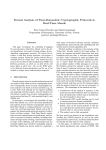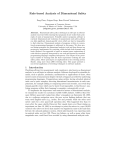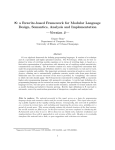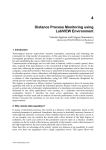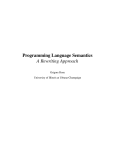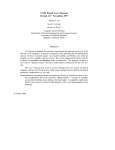Download slides - Formal Systems Laboratory
Transcript
1 Programming Language Semantics Maude Grigore Roşu Department of Computer Science University of Illinois at Urbana-Champaign 2 General Information about Maude Maude is an executable specification language supporting rewrite logic specifications and having at its core a very fast rewrite engine. We will use Maude as a platform for executing programming language definitions following various definitional styles. Our short term objectives are: 1. Learn how to use Maude; 2. Show how various language definitional styles, including the ones discussed so far or to be discussed (big-step and small-step SOS, MSOS, reduction semantics with evaluation contexts, the CHAM, denotational semantics) can be formally defined in Maude; 3 Maude’s roots go back to Clear (Edinburgh) in 1970s and to OBJ (Stanford, Oxford) in 1980s. There are many other languages in the same family, such as CafeOBJ (Japan), BOBJ (San Diego, California), ELAN (France). Maude is currently being developed at Stanford Research Institute and at the University of Illinois at Urbana-Champaign. You can find more about Maude, including a manual and many papers and examples, on its webpage at http://maude.cs.uiuc.edu. Due to the fact that Maude is executable, interpreters for programming languages defined in Maude will be obtained for free, which will be very useful for understanding, refining and/or changing the languages. 4 Moreover, analysis tools for the specified languages can also be obtained with little effort, such as type checkers, abstract interpreters or model-checkers, either by using analysis tools already provided by Maude or by deriving them explicitly from a language definition. Devising formal semantic executable models of desired languages or tools before these are implemented is a crucial step towards a deep understanding of the language or tool. In simplistic terms, it is like devising a simulator for an expensive system before building the actual system. 5 However, our “simulators” in this class will consist of exactly the semantics, or the meaning, of our desired systems, defined using a very rigorous, mathematical notation. In the obtained formal executable model of a programming language, “executing a program” will correspond to nothing but logical inference within the semantics of the language. Maude is easy to install and should run on the assigned machines. Type maude and you should see a welcome screen like the following: 6 bash$ maude \||||||||||||||||||/ --- Welcome to Maude --/||||||||||||||||||\ Maude 2.5 built: May 7 2010 18:28:32 Copyright 1997-2010 SRI International Wed Sep 1 10:16:41 2010 Maude> You can download Maude from its web page at http://maude.cs.uiuc.edu. Unix/Linux is preferred, but it also works on Windows. Also save its user manual. You will need it. 7 How to Use Maude Maude is interpreted; just type your specifications and commands. Better way to use it: 1. Type everything in one file, say p.maude 2. Start Maude 3. Include that file with the command “in p” or “in p.maude” 4. Use “quit” or “q”, to quit. 8 Modules Specifications are introduced as modules, or theories. We will use only general modules in this class, which have the syntax mod <NAME> is <BODY> endm The <BODY> can include • Importation of other modules • Sort and operation declarations, forming the signature of that module; this is the interface of that module to the outside world • Sentences. 9 We will use modules to define programming language features. These features can be then imported by other modules, which can extend them or use them to define other features. A programming language will be also defined as a module, namely one importing all the modules defining its desired features. Let us exemplify this paradigm by defining the simplest programming language that we will see in this class. It is so simple, that it does not even deserve to be called a “programming language”, but we do so for the sake of a uniform terminology. The language specified in what follows defines natural numbers with addition and multiplication. One module will define the feature “addition” and another will define the feature “multiplication” on top of addition. 10 An Example: Peano Natural Numbers The following defines natural numbers with successor and addition, using Peano’s axiomatization: mod PEANO-NAT is sort Nat . op zero : -> Nat . op succ : Nat -> Nat . op plus : Nat Nat -> Nat . vars N M : Nat . eq plus(zero, M) = M . eq plus(succ(N), M) = succ(plus(N, M)) . endm Declarations are separated by periods, which should typically have white spaces before and after. 11 Signatures One sort, Nat, and three operations, zero, succ, and plus, form the signature of PEANO-NAT. Sorts are declared with the keywords sort or sorts, and operations with op or ops. The three operations have zero, one and two arguments, resp., whose sorts are between : and ->. Operations of zero arguments are also called constants, those of one argument are called unary and those of two binary. The result sort appears after ->. Use ops when two or more operations of same arguments are declared together, and use white spaces to separate them: ops plus mult : Nat Nat -> Nat . There are few special characters in Maude. If you use op in the above then only one operation, called “plus mult”, is declared. 12 Equations The two equations in PEANO-NAT are “properties”, or constraints, that these operations should satisfy. More precisely, any correct implementation of Peano natural numbers should satisfy them. All equations are quantified universally, so we should read “for all M and N of sort Nat, plus(s(N), M) = s(plus(N,M))”. All equations in a module can be used in reasoning about the defined structures. Exercise 1 Prove that any correct implementation of PEANO-NAT should satisfy the property plus(succ(succ(zero)), succ(succ(succ(zero)))) = plus(succ(succ(succ(succ(zero)))), succ(zero)). Equations can be applied from left-to-right or from right-to-left in reasoning, which means that equational proofs may require exponential search, thus making them theoretically intractable. 13 Rewriting Maude regards all equations as rewriting rules, which means that they are applied only from left to right. Thus, any well-formed term can either be derived infinitely often, or be reduced to a normal form, which cannot be reduced anymore by applying equations as rewriting rules. Maude’s command to reduce a term to its normal form is reduce or simply red. Reduction will be made in the last defined module: Maude> reduce plus(succ(succ(zero)), succ(succ(succ(zero)))) . rewrites: 3 in 0ms cpu (0ms real) (~ rewrites/second) result Nat: succ(succ(succ(succ(succ(zero))))) Maude> Millions of rewrites per second can be performed, for which reason Maude can be (almost) used as a programming language. 14 Importation Modules can be imported, using the keywords protecting, extending or including. The difference between these importation modes is subtle and semantical rather than operational. Fell free to use including, the most general of them, all the time and read the manual for more information. The following module extends PEANO-NAT with multiplication: mod PEANO-NAT* is including PEANO-NAT . op mult : Nat Nat -> Nat . vars M N : Nat . eq mult(zero, M) = zero . eq mult(succ(N), M) = plus(mult(N, M), M) . endm Variable declarations are not imported. 15 Putting it all Together We can now define our simple programming language and “execute programs” (in this case, PEANO-NAT* already had all the features): mod SIMPLEST-PROGRAMMING-LANGUAGE is including PEANO-NAT . including PEANO-NAT* . endm red mult(succ(succ(zero)), mult(succ(succ(zero)), succ(succ(zero)))) . The following is Maude’s output: reduce in SIMPLEST-PROGRAMMING-LANGUAGE : mult(succ(succ(zero)), mult(succ(succ(zero)), succ(succ(zero)))) . rewrites: 16 in 0ms cpu (0ms real) (~ rewrites/second) result Nat: succ(succ(succ(succ(succ(succ(succ(succ(zero)))))))) Even though this language is very simple and its syntax is ugly, it 16 nevertheless shows a formal and executable definition of a language using equational logic and rewriting. Our languages or analysis tools discussed in this class will be defined in a relatively similar manner, though, as expected, they will be more involved. For example, a notion of state will be needed, as well as several control structures. 17 The Mix-fix Notation Some operations are prefix, but others are infix, postfix, or mix-fix, i.e., arguments can occur anywhere, like in the case of if then else . Maude supports mix-fix notation by allowing the user to place the arguments of operations wherever one wants by using underscores. Here are some examples: op op op op _+_ : Int Int -> Int . _! : Nat -> Nat . in_then_else_ : BoolExp Stmt Stmt -> Stmt . _?_:_ : BoolExp Exp Exp -> Exp . Exercise 2 Rewrite PEANO-NAT and PEANO-NAT* using mix-fix notation. What happens if you try to reduce an expression containing both + and * without parentheses? 18 BNF (Bachus-Naur Form) or CFG (Context Free Grammar) notations to describe the syntax of programming languages are very common. We also used BNF to define the syntax of our simple language in the lectures on SOS. From here on, we can interchangeably use the mix-fix notation instead of BNF or CFG, so it is important to understand the relationship between the mix-fix notation and BNF and CFG: Exercise 3 Argue that the mix-fix notation is equivalent to BNF and CFG. Find an interesting simple example language and express its syntax using the mix-fix notation, BNF, and production-based CFG (e.g., A → AB | a and B → BA | b). 19 Parsing Mix-fix notation leads to an interesting problem, that of parsing. In the modified PEANO-NAT* of Ex. 2, how do we parse x + y * z? Maude has a command called parse, which parses a term using the syntax of the most recently defined module. To see all the parentheses, first type the command “set print with parentheses on .” (see Subsection 17.5 in Maude’s manual). “parse x + y * z .” reports ambiguous parsing. Use parentheses to disambiguate parsing, such as “parse x + (y * z) .”. To give priorities to certain operators in order to reduce the number of parentheses, use precedence attribute when you declare operators: op _+_ : Int Int -> Int [prec 33] . op _*_ : Int Int -> Int [prec 31] . The lower the precedence the stronger the binding! 20 Maude has several builtin modules, including ones for natural and integer numbers. The operations + and * have precedences 33 and 31, respectively, in these builtin modules. With these precedences, one can parse as follows: Maude> set print with parentheses on . Maude> parse -10 + 2 * 3 . Int: (-10 + (2 * 3)) Sometimes, especially when debugging, the mixfix notation may be confusing. If you wish to turn it off, use the command: Maude> set print mixfix off . Maude> parse -10 + 2 * 3 . Int: _+_(-10, _*_(2, 3)) 21 Associativity, Commutativity and Identity Attributes Many of the binary operations that will be used in this class will be associative (A), commutative (C) or have an identity (I), or combinations of these. E.g., + is associative, commutative and has 0 as identity. All these can be added as attributes to operations when declared: op _+_ : Int Int -> Int [assoc comm id: 0 prec 33] . op _*_ : Int Int -> Int [assoc comm id: 1 prec 31] . Notice that each of the A, C, and I attributes are logically equivalent to appropriate equations, such as eq A + (B + C) = (A + B) + C . eq A + B = B + A . ---> attention: rewriting does not terminate! eq A + 0 = A . Then why are the ACI attributes necessary? For several reasons: 22 1. Associativity removes the need for useless parentheses: Maude> parse -10 + 2 + 3 . Int: -10 + 2 + 3 2. Commutativity will allow rewriting to terminate. The normal form will, however, be modulo commutativity. 3. ACI matching is perhaps the most interesting reason. It will be described next. 23 Matching Modulo Attributes Lists occur in many programming languages. The following module is a an elegant but tricky specification for lists of integers with a membership operation in : mod INT-LIST is protecting INT . sort IntList . subsort Int < IntList . op nil : -> IntList . op __ : IntList IntList -> IntList [assoc id: nil] . op _in_ : Int IntList -> Bool . var I : Int . vars L L’ : IntList . eq I in L I L’ = true . eq I in L = false [owise] . endm 24 Note the declaration “subsort Int < IntList .”, which says that integers are also lists of integers. Then the constant nil and the concatenation operation can generate any finite list of integers: Maude> parse 1 2 3 4 5 . IntList: 1 2 3 4 5 Maude> red 1 nil 2 nil 3 nil 4 nil 5 6 7 nil . result IntList: 1 2 3 4 5 6 7 Further, by AI matching, the membership operation can be defined without having to traverse the list element by element! Maude> result Maude> result Maude> result red 3 Bool: red 3 Bool: red 3 Bool: in 2 3 4 . true in 3 4 5 . true in 1 2 4 . false By AI matching, I, L, and L’ in the left-hand-side term of “eq I 25 in L I L’ = true .” can match any integer or lists of integers, respectively, including nil. Since I can only be matched by 3, the other matches follow automatically. The attribute owise in “eq I in L = false [owise] .” tells Maude to apply that equation only “otherwise”, that is, only if no other equation, in this case the previous one only, can be applied. If one wants to define sets of integers, then, besides replacing the sort IntList probably by IntSet, one has to declare the concatenation also commutative, and one has to replace the first equation by “eq I in I L = true .”. Exercise 4 Define a Maude module called INT-SET specifying sets of integers with membership, union, intersection and difference (elements in one set and not in the other). The matching modulo attributes are implemented very efficiently in Maude, so you (typically) don’t have to worry about efficiency. 26 Built-in Modules There are several built-in modules. We will use the following: • BOOL. Provides a sort Bool with two constants true, false and basic boolean calculus, together with if then else fi and == operations. The later takes two terms, reduces them to their normal forms, and then returns true iff they are equal (modulo ACI, as appropriate); otherwise it returns false. • INT. Provides a sort Int, arbitrary large integers as constants of sort Int, together with the usual operations on these. • QID. Provides a sort Qid together with arbitrary large quoted identifiers, as constants of sort Qid, of the form: ’a, ’b, ’a-larger-identifier, etc. To see an existing module, built-in or not, type the command Maude> show module <NAME> . 27 For example, “show module BOOL .” will output mod BOOL is protecting TRUTH . op _and_ : Bool Bool -> Bool [assoc comm prec 55] . op _or_ : Bool Bool -> Bool [assoc comm prec 59] . op _xor_ : Bool Bool -> Bool [assoc comm prec 57] . op not_ : Bool -> Bool [prec 53] . op _implies_ : Bool Bool -> Bool [prec 61 gather (e E)] . vars A B C : Bool . eq true and A = A . eq false and A = false . eq A and A = A . eq false xor A = A . eq A xor A = false . eq not A = A xor true . eq A and (B xor C) = A and B xor A and C . eq A or B = A and B xor A xor B . eq A implies B = not (A xor A and B) . endm Exercise 5 Use the command “show module <NAME> .” on the three modules above and try to understand them. 28 Constructor versus Defined Operations When we defined the operation plus on Peano natural numbers, we defined it recursively on numbers of the form zero and succ(N). Why did we do that, considering that PEANO-NAT had declared three operations: op zero : -> Nat . op succ : Nat -> Nat . op plus : Nat Nat -> Nat . Intuitively, the reason is that because we want plus to be completely defined in terms of zero and succ. Formally, this means that any term over the syntax zero, succ, and plus can be shown, using the given equations, equal to a term containing only zero and succ operations, that is, zero and succ alone are sufficient to build any Peano number. For that reason, they are called constructors. 29 Defining Operations using Constructors There is no silver-bullet recipe on how to define “defined” operators, but essentially the main (safe) idea is to Define the operator’s “behavior” on each constructor. That is what we did when we defined plus in PEANO-NAT and mult in PEANO-NAT*: we first defined them on zero and then on succ. In general, if c1, ..., cn are the intended constructors of a data-type, in order to define a new operation d, make sure that all equations eq d(c1(X1,...)) = ... ... eq d(cn(Xn,...)) = ... are in the specification. This gives no guarantee (e.g., one can “define” plus as plus(succ(M),N) = plus(succ(M),N)), but it is a good enough principle to follow. 30 Defining Operations on Lists Let us consider the following specification of lists: mod INT-LIST is protecting INT . sort IntList . subsort Int < IntList . op __ : Int IntList -> IntList [id: nil] . op nil : -> IntList . endm Therefore, there are two constructors for lists: the empty list and the concatenation of an integer to a list. Let us next define several other important and useful operations on lists. Notice that the definition of each operator treats each of the constructors separately. 31 The following defines the usual length operator: mod LENGTH is protecting INT-LIST . op length : IntList -> Nat . var I : Int . var L : IntList . eq length(I L) = 1 + length(L) . eq length(nil) = 0 . endm red length(1 2 3 4 5) . ***> should be 5 32 The following defines membership, without speculating matching (in fact, this would not be possible anyway because concatenation is not defined associative as before): mod IN is protecting INT-LIST . op _in_ : Int IntList -> Bool . vars I J : Int . var L : IntList . eq I in J L = if I == J then true else I in L fi . eq I in nil = false . endm red red red red 3 3 3 3 in in in in 2 3 1 1 3 4 2 2 4 5 3 4 . . . . ***> ***> ***> ***> should should should should be be be be true true true false 33 The next operator appends two lists of integers: mod APPEND is protecting INT-LIST . op append : IntList IntList -> IntList . var I : Int . vars L1 L2 : IntList . eq append(I L1, L2) = I append(L1, L2) . eq append(nil, L2) = L2 . endm red append(1 2 3 4, 5 6 7 8) . ***> should be 1 2 3 4 5 6 7 8 34 The following imports APPEND and defines an operation which reverses a list: mod REV is protecting APPEND . op rev : IntList -> IntList . var I : Int . var L : IntList . eq rev(I L) = append(rev(L), I) . eq rev(nil) = nil . endm red rev(1 2 3 4 5) . ***> should be 5 4 3 2 1 35 The next module defines an operation which sorts a list of integers by insertion sort: mod ISORT is protecting INT-LIST . op isort : IntList -> IntList . vars I J : Int . var L : IntList . eq isort(I L) = insert(I, isort(L)) . eq isort(nil) = nil . op insert : Int IntList -> IntList . eq insert(I, J L) = if I > J then J insert(I,L) else I J L fi . eq insert(I, nil) = I . endm red isort(4 7 8 1 4 6 9 4 2 8 3 2 7 9) . ***> should be 1 2 2 3 4 4 4 6 7 7 8 8 9 9 36 Defining Operations on Binary Trees Let us now consider a specification of binary trees, where a tree can be either empty or an integer with a left and a right subtree: mod TREE is protecting INT . sort Tree . op ___ : Tree Int Tree -> Tree . op empty : -> Tree . endm We next define some operations on such trees, also following the structure of the trees given by the two constructors above. 37 The next simple operation simply mirrors a tree, that is, it recursively replaces each left subtree by the mirrored right subtree and vice-versa: mod MIRROR is protecting TREE . op mirror : Tree -> Tree . vars L R : Tree . var I : Int . eq mirror(L I R) = mirror(R) I mirror(L) . eq mirror(empty) = empty . endm red mirror((empty 3 (empty 1 empty)) 5 ((empty 6 empty) 2 empty)) . ***> should be (empty 2 (empty 6 empty)) 5 ((empty 1 empty) 3 empty) 38 Searching in binary trees can be defined as follows: mod SEARCH is protecting TREE . op search : Int Tree -> Bool . vars I J : Int . vars L R : Tree . eq search(I, L I R) = true . eq search(I, L J R) = search(I, L) or search(I, R) [owise] . eq search(I, empty) = false . endm red search(6, (empty 3 (empty 1 empty)) 5 ((empty 6 empty) 2 empty)) . ***> should be true red search(7, (empty 3 (empty 1 empty)) 5 ((empty 6 empty) 2 empty)) . ***> should be false Notice the use of the attribute [owise] for the second equation. Exercise 6 Define search with only two equations, by using the built-in if then else fi. 39 Putting Together Trees and Lists We next define a module which imports both modules of trees and of lists on integers, and defines an operation which takes a tree and returns the list of all integers in that tree, in an infix traversal: mod FLATTEN is protecting APPEND . protecting TREE . op flatten : Tree -> IntList . vars L R : Tree . var I : Int . eq flatten(L I R) = append(flatten(L), I flatten(R)) . eq flatten(empty) = nil . endm red flatten((empty 3 (empty 1 empty)) 5 ((empty 6 empty) 2 empty)) . ***> should be 3 1 5 6 2 Exercise 7 Do the same for prefix and for postfix traversals. 40 Exercise 8 Write an executable specification in Maude that uses binary trees to sort lists of integers. You should define an operation btsort : IntList -> IntList, which sorts the argument list of integers, as isort did above. In order to define it, define another operation bt-insert : IntList Tree -> Tree, which inserts each integer in the list at its place in the tree, and also use the already defined flatten operation.








































